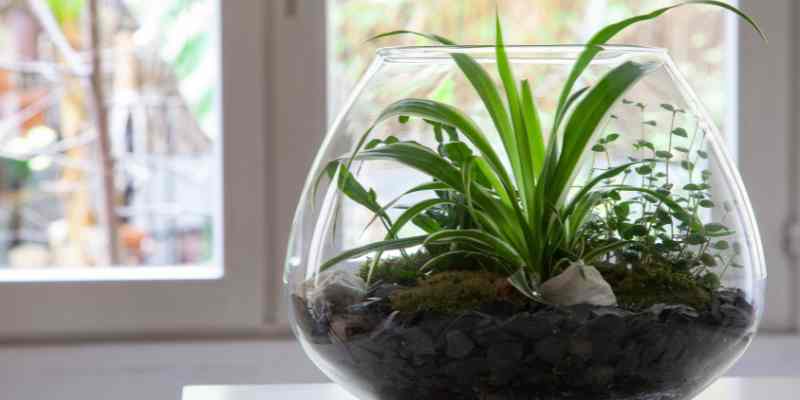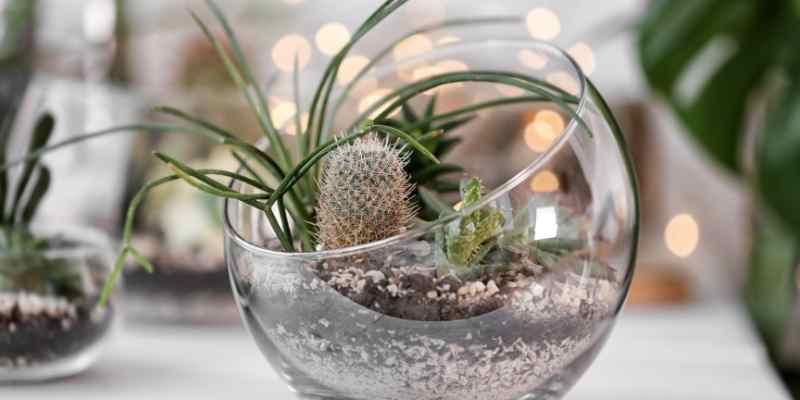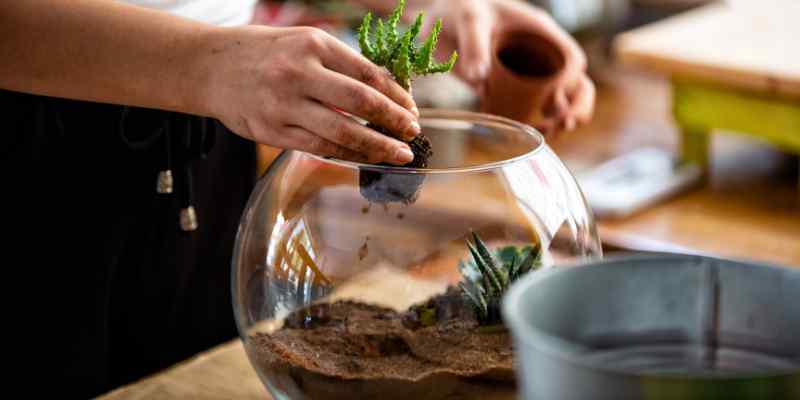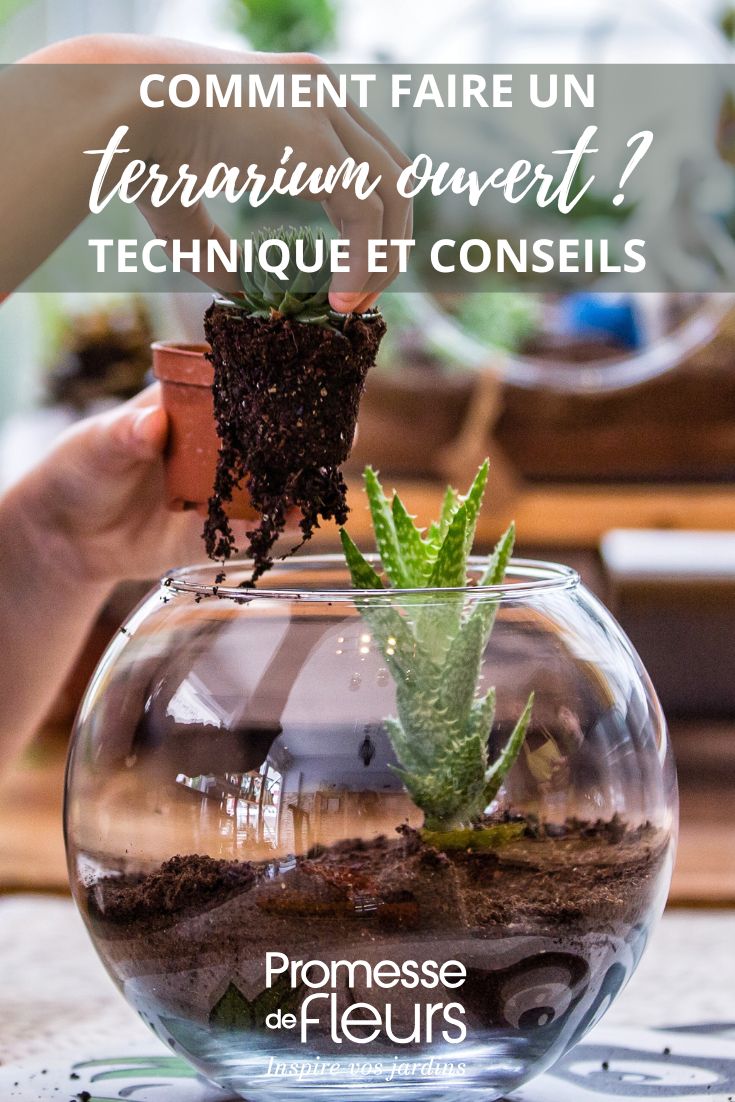- Container: a transparent glass jar with a wide opening to allow good ventilation. This could be a fishbowl, a round vase with a wide opening, a sweet jar with the lid removed, a pretty recycled jar, or even a glass and brass box, like a jewellery box. It must be perfectly clean and dry before starting.
- Substrate: this will vary depending on the type of plants.
- For a succulent terrarium: a light mix, such as special cactus soil or a half-soil, half-sand blend.
- For a green plant terrarium: special green plant soil mixed with a handful of activated charcoal flakes to prevent bacterial growth and bad odours.
- Gravel, clay pebbles, or pumice for the drainage layer.
- Plants: succulents, cacti for a dry open terrarium, or small green plants that tolerate a dry environment (see above).
- Decorative elements (optional): stones, moss, shells, pieces of driftwood, etc.
- Tools: long tweezers for handling plants or objects, a small trowel (optional), gloves for cacti, a spray bottle for watering.
- For succulents: pour a layer of light substrate (see above) of 5 to 10 cm over the activated charcoal. Lightly tamp down the substrate to create a stable surface. Optionally, add a thin layer of activated charcoal over the gravel.
- For green plants: use the special green plant soil mixed with a handful of activated charcoal flakes. This helps keep the substrate healthy and prevents bad odours. Add a layer of 5 to 10 cm, depending on the depth of the jar.
A terrarium is a trendy alternative to traditional houseplants in our interiors: beautiful and aesthetic, it allows you to host mini plants, whether jungle or desert-themed, in a glass jar. If you're new to creating terrariums, an open terrarium is probably the simplest and most rewarding choice. Follow our tips to create your own homemade terrarium: a creative activity, easier than you think, to recreate a miniature ecosystem at home!

An open terrarium… for which plants and which location?
This is a classic terrarium but without an airtight lid or cork stopper. The open terrarium is therefore particularly suited to growing succulents (succulent plants and cacti), as it promotes good air circulation and limits ambient humidity. It is very easy to maintain. But it can also be considered for planting mini green plants that are well-suited, if the container is deep enough, like a miniature jungle garden in your living room.
So, your preference and the style of plants you love will define your dream open terrarium! As you might guess, the amount of light will also determine the choice of plants. The brighter and warmer the room, the more suitable it will be for a mini cactus garden. Playing both a decorative and experimental role, the open terrarium has its place in urban interiors where space is limited, as well as in larger living spaces, placed on a piece of furniture, inevitably sparking curiosity.

Which plants to choose and how many plants to plan for?
Opt for mini plugs for small open terrariums, or miniature potted plants, as they will adapt better to the limited space. This will greatly facilitate planting and arranging the plants in the container. You can include a few plants that will slightly overflow the pot, or trailing plants if you hang your terrarium.
Slow growth is an important criterion when selecting plants for an open terrarium. This helps maintain a harmonious composition without the plants outgrowing the available space. Finally, always group plants from the same environment together, as they do not have the same needs in terms of substrate or watering.
Here are some examples of compact or dwarf plants, ideal for an open terrarium:
Succulents and cacti for an arid theme
Prioritise dwarf succulents like Haworthia, Gasteria, Echeveria, Crassula ovata 'Minor', indoor Sedums such as Sedum rubrotinctum, Pachyphytum oviferum, a dwarf Aloe vera, and/or small cacti like Mammillaria, Gymnocalycium, Rebutia, or Echinopsis.
Green plants for a miniature jungle-effect terrarium
Mix compact ferns (Davallia fejeensis, Asplenium bulbiferum, Selaginella kraussiana), an Asparagus plumosus, very low and dense plants, resembling moss, like Sagina subulata or Soleirolia soleirolii, and plants with colourful or unique foliage (Fittonia, Pilea glauca, Peperomia 'Hope', Asparagus plumosus).
Note: miniature orchids (Masdevallia, Pleurothallis, etc.) require high ambient humidity, often difficult to maintain without a lid… As for carnivorous plants (Pinguicula and Drosera Capensis), they could be grown together, but they require very specific conditions, like in open ground (here, demineralised water and very high humidity), best reserved for experts.

Number of plants and spacing
For a large terrarium of 20 cm in diameter, plan for about 3 to 5 small plants of 3-5 cm in diameter. This allows for a varied composition without overcrowding the space.
Leave approximately 2 to 3 cm between each plant to ensure good air circulation and avoid competition for root space. Keep a border of at least 1 to 2 cm between the plants and the terrarium walls to prevent the leaves from touching the glass, which could encourage rot with jungle-style green plants.
Prepare your materials
The terrarium requires a number of specific elements. Make sure to source and purchase not only the plants but also the essential accessories:

Assemble your terrarium in 5 steps
1. Drain the bottom of the jar
First, place the drainage material at the bottom of the container, about 4 to 5 cm deep. This will allow excess water to drain and prevent root rot. This is essential for both "dry" and "humid" terrariums.

2. Add the substrate
3. Plant
Dig small holes in the substrate with the mini trowel and gently place your plants in them. Remember to leave enough space between each plant to ensure good air circulation.
Start by planting the largest plants or those with the most developed root systems. This helps structure the space and ensures the roots have enough room to spread.
Next, add medium-sized plants, arranging them around the larger ones. Fill the gaps with small plants, ensuring a balanced visual effect.
If you're using trailing plants, like Senecio (syn. Curio) rowleyanus or Ceropegia woodii, place them near the edges of the container so they can spill over elegantly.
Gently tamp down the substrate around the roots to stabilise them.
For cacti, add a little gravel, shells, or pumice for decoration and to prevent the collar from rotting. For a more humid environment, use your long tweezers to place moss (collected from the garden, which works perfectly!).

4. Decorate and water
Optionally, arrange a few decorative elements (pebbles, pieces of wood, figurines, etc.) to personalise your terrarium. Then water differently depending on the plants:
































Comments